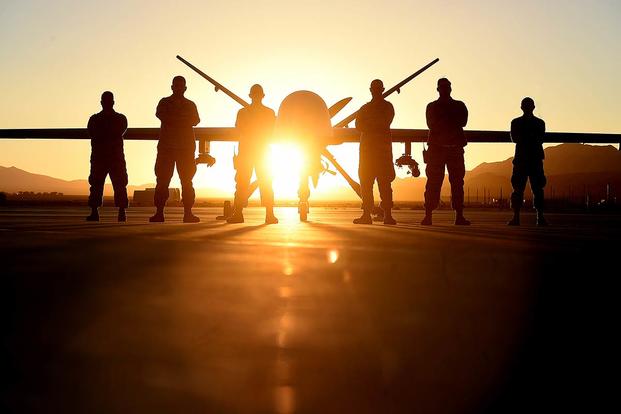The unmanned mission for the Air National Guard has become a sweet spot for airmen not only looking to maintain a part-time Air Force career, but also to develop their skills at a time when the service is making strides in drone capabilities, the head of the National Guard Bureau said.
"I saw many former F-16 units go kicking and screaming into the [MQ-1] Predator mission and now, almost, you can't go to one of these places [without them] telling you, 'We regret resisting this,' " Gen. Joseph Lengyel told defense reporters last week in Washington, D.C.
Lengyel said Air Force leaders worried at first about how the remotely piloted aircraft mission would impact airmen in the long term as they aimed to rapidly grow the drone field.
The service plans "to add 2,500-3,000 personnel to the [remotely piloted aircraft, or RPA] enterprise" as a whole through its Culture and Process Improvement Program, Air Combat Command spokesman Benjamin Newell told Military.com last month.
RELATED: Air Force Seeks to Change How Drone Pilots Train, Fly
"We've been able to build up the enterprise such that the quality of life, work schedules for our Guardsmen have been built in a more sustainable kind of … rhythm, working 12-hour days, six days a week," Lengyel said.
Lengyel cited units in Fargo, North Dakota, and Ellington Field in Houston as examples of recently transitioned units where "you'll see all those folks going to university at night, but flying Predator missions during the day."
But even that lifestyle may be on the cusp of an overhaul in the next few years.
"I think RPA in general is a growing industry, not just in defense, but automated, requiring less people to actually control an airborne platform … there will be more of that," he said.
"It's an insatiable product that it produces -- I don't know a single unit that isn't highly motivated and ready to do it."
More Automation (and Swarming)
Without disclosing details of how the service may start automating its drones, the why is clear: The demand for robotics is on the rise.
Air Force Col. Brandon Baker, chief of the remotely piloted aircraft capabilities division, last week said the service is investing in small unmanned aerial systems technologies to operate in a much different sphere "than RPA systems today."
He envisioned an Ender's Game-style battle, in which an airman -- nonaligned to a ground station -- would be able to control swarms of drones, "thousands of platforms at the wave of a hand."
"We're looking at something different, not man in the loop operations, but man on the loop operations, meaning our levels of autonomy and levels of cognition have to increase," Baker said during the Unmanned Systems Defense Conference outside Washington, D.C.
The Air Force reached out to the Defense Department's Defense Innovation Unit Experimental, or DIUX, in Silicon Valley to test the concept, he said.
"We're not going to be flying these airplanes, we're going to [be] orchestrating where these airplanes go, what they do," Baker said, adding that the service will need more individuals who are "air minded, folks who understand …. application of airpower" for these roles, especially when it comes to drone swarming in highly contested environments.
Marine Corps Lt. Gen. Robert Walsh, the service's commanding general for combat development, detailed a similar plan at last week's conference to incorporate swarming, or bringing in small unmanned aerial vehicles paired with underwater drones, unmanned surface vessels and underwater mine countermeasures, to storm areas -- either on land, air or sea -- in hopes it would not only slow down the enemy but save troops' lives.
RELATED: Drone Swarms to Storm Beaches: Marine General
"Instead of Marines being the first wave in, it'll be unmanned robotics … sensing, locating and maybe killing out front of those Marines," Walsh said. "We see that 'swarm-type' technology as exactly the type of thing -- it will lower cost, dominate the battlespace, leverage capabilities … and be able to complicate the problems for the enemy."
Echoing Walsh, Baker said, "We're seeing a lot of development in these areas. Manpower, efficiencies and the future for United States Air Force … has got to be baked in from the beginning. It's a must-have."
-- Oriana Pawlyk can be reached at oriana.pawlyk@military.com. Follow her on Twitter at @Oriana0214.





























